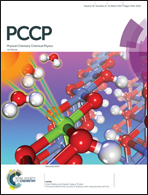Influence of lanthanide ion energy levels on luminescence of corresponding metalloporphyrins†
Abstract
Lanthanide (Ln) porphyrins exhibit diverse luminescence properties that have not been fully explained yet. A series of Ln ions (Ln ions = La3+, Ce3+, Pr3+, Nd3+, Sm3+, Eu3+, Gd3+, Tb3+, Dy3+, Ho3+, Er3+, Tm3+, Yb3+, and Lu3+) were coordinated with hematoporphyrin monomethyl ether (HMME), and their luminescence properties and related differences were studied. Spectral analysis indicated that all Ln–HMMEs exhibit fluorescence emission. Gd– and Lu–HMMEs were the only lanthanide–HMMEs displaying strong molecular π–π room-temperature phosphorescence (RTP) with quantum yield ΦP > 10−3. Tb3+ can also induce RTP from HMME but ΦP of Tb–HMME is much smaller (ΦP ∼ 10−4). The observed luminescence property differences were analyzed in detail, focusing on the 4f energy levels of Ln ions. These levels mostly lie below the lowest singlet (S1) and triplet (T1) excited states of HMME, resulting in energy transfer from the T1 state in HMME to Ln ions and, therefore, in the absence of RTP from the corresponding metalloporphyrins. Gd3+ and Lu3+ are the only lanthanide ions not possessing such 4f energy levels, avoiding T1 quenching in Gd– and Lu–HMMEs. Although Tb3+ has low-lying 4f energy levels, the corresponding transition from the ground state is partly forbidden, resulting in weak energy transfer from HMME to Tb3+ that accounts for the low RTP quantum yield of the corresponding complex. Thus, our results indicate that the luminescence property differences of lanthanide porphyrins are due to the disparate energy levels of the Ln ions.



 Please wait while we load your content...
Please wait while we load your content...